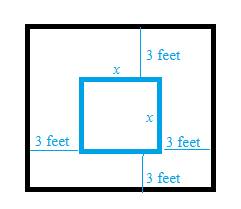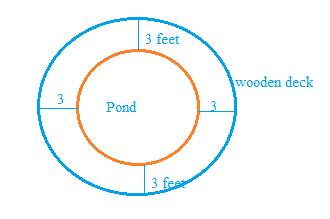
Concept explainers
a.
To find: The dimension of the pond.
a.
Answer to Problem 36AYU
Dimension of the pond would be
Explanation of Solution
Given information:
A square pond has
Calculation:
As per the given information −
A square pond has
Let us suppose the side length of square pond is

Total perimeter of the border would be
Hence, dimension of the square pond would be
b.
To find: The dimension of the rectangular pond.
b.
Answer to Problem 36AYU
Dimension of the rectangular pond would be
Explanation of Solution
Given information:
A rectangular pond has
Calculation:
As per the given information −
A square pond has
Let us suppose the width of rectangular pond is
Total perimeter of the border would be
Hence, dimension of the rectangular pond would be
c.
To find: The dimension of the circular pond.
c.
Answer to Problem 36AYU
Dimension of the circular pond would be
Explanation of Solution
Given information:
A circular pond has
Calculation:
As per the given information −
A circular pond has
Let us suppose the diameter of circular pond is

Total perimeter of the border would be
Hence, diameter of the circular pond would be
d.
To find: Which pond has the most area.
d.
Answer to Problem 36AYU
Circular pond has most area.
Explanation of Solution
Given information:
Same as part
Calculation:
Dimension of the square pond is
Area of the square pond would be
Dimension of the rectangular pond is
Area of the rectangular pond would be
Diameter of the circular pond is
Area of the circular pond would be
Hence, circular pond has most area.
Chapter A Solutions
Precalculus
Additional Math Textbook Solutions
A Problem Solving Approach To Mathematics For Elementary School Teachers (13th Edition)
Thinking Mathematically (6th Edition)
Elementary Statistics: Picturing the World (7th Edition)
Basic Business Statistics, Student Value Edition
A First Course in Probability (10th Edition)
Elementary Statistics
- A 20 foot ladder rests on level ground; its head (top) is against a vertical wall. The bottom of the ladder begins by being 12 feet from the wall but begins moving away at the rate of 0.1 feet per second. At what rate is the top of the ladder slipping down the wall? You may use a calculator.arrow_forwardExplain the focus and reasons for establishment of 12.4.1(root test) and 12.4.2(ratio test)arrow_forwarduse Integration by Parts to derive 12.6.1arrow_forward
- Explain the relationship between 12.3.6, (case A of 12.3.6) and 12.3.7arrow_forwardExplain the key points and reasons for the establishment of 12.3.2(integral Test)arrow_forwardUse 12.4.2 to determine whether the infinite series on the right side of equation 12.6.5, 12.6.6 and 12.6.7 converges for every real number x.arrow_forward
- use Corollary 12.6.2 and 12.6.3 to derive 12.6.4,12.6.5, 12.6.6 and 12.6.7arrow_forwardExplain the focus and reasons for establishment of 12.5.1(lim(n->infinite) and sigma of k=0 to n)arrow_forwardExplain the focus and reasons for establishment of 12.5.3 about alternating series. and explain the reason why (sigma k=1 to infinite)(-1)k+1/k = 1/1 - 1/2 + 1/3 - 1/4 + .... converges.arrow_forward
 Calculus: Early TranscendentalsCalculusISBN:9781285741550Author:James StewartPublisher:Cengage Learning
Calculus: Early TranscendentalsCalculusISBN:9781285741550Author:James StewartPublisher:Cengage Learning Thomas' Calculus (14th Edition)CalculusISBN:9780134438986Author:Joel R. Hass, Christopher E. Heil, Maurice D. WeirPublisher:PEARSON
Thomas' Calculus (14th Edition)CalculusISBN:9780134438986Author:Joel R. Hass, Christopher E. Heil, Maurice D. WeirPublisher:PEARSON Calculus: Early Transcendentals (3rd Edition)CalculusISBN:9780134763644Author:William L. Briggs, Lyle Cochran, Bernard Gillett, Eric SchulzPublisher:PEARSON
Calculus: Early Transcendentals (3rd Edition)CalculusISBN:9780134763644Author:William L. Briggs, Lyle Cochran, Bernard Gillett, Eric SchulzPublisher:PEARSON Calculus: Early TranscendentalsCalculusISBN:9781319050740Author:Jon Rogawski, Colin Adams, Robert FranzosaPublisher:W. H. Freeman
Calculus: Early TranscendentalsCalculusISBN:9781319050740Author:Jon Rogawski, Colin Adams, Robert FranzosaPublisher:W. H. Freeman
 Calculus: Early Transcendental FunctionsCalculusISBN:9781337552516Author:Ron Larson, Bruce H. EdwardsPublisher:Cengage Learning
Calculus: Early Transcendental FunctionsCalculusISBN:9781337552516Author:Ron Larson, Bruce H. EdwardsPublisher:Cengage Learning





